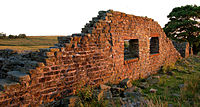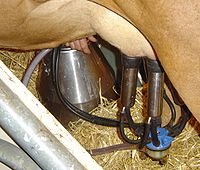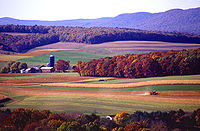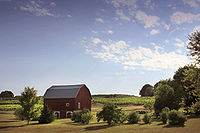
Farm
Background to the schools Wikipedia
This selection is made for schools by a children's charity read more. Do you want to know about sponsoring? See www.sponsorachild.org.uk
A farm is an area of land, including various structures, devoted primarily to the practice of farming, the production and management of food, either produce or livestock (see also ranching). It is the basic production facility in food production. Farms may be owned and operated by a single individual, family, or community, or by a corporation or company. A farm can be a holding of any size from a fraction of a hectare to several thousand hectares.
A business producing tree fruits or nuts is called an orchard; a vineyard produces raisins, wine or table grapes. The stable is used for operations principally involved in the production of horses and other animals and livestock. A farm that is primarily used for the production of milk and dairy is a dairy farm. A market garden or truck farm is a farm that raises vegetables, but little or no grain. Additional specialty farms include fish farms, which raise fish in captivity as a food source, and tree farms, which grow trees for sale for transplant, lumbering, or decorative use. A plantation is usually a large farm or estate, on which cotton, tobacco, coffee, or sugar cane, are cultivated, usually by resident laborers.
The development of farming and farms was an important component in establishing towns. Once people have moved from hunting and/or gathering and from simple horticulture to active farming, social arrangements of roads, distribution, collection, and marketing can evolve. With the exception of plantations and colonial farms, farm sizes tend to be small in newly-settled lands and to extend as transportation and markets become sophisticated. Farming rights have been the central tenet of a number of revolutions, wars of liberation, and post-colonial economics.
-
A typical North American grain farm with farmstead in Ontario, Canada
-
Farmlands in Hebei province, China
Etymology
The word came via French ferme from Late Latin firma = "fixed payment" from Latin firmus = "firm, solid", and originally referred to a big landowner farming out his land among other men to run it, rather than running it all himself. As times have changed fewer people are needed to assist in running the farm because of the increase of mechanization.
Farming
The term farming covers a wide spectrum of agricultural production work. At one end of this spectrum is the subsistence farmer, who farms a small area with limited resource inputs, and produces only enough food to meet the needs of his/her family. At the other end is commercial intensive agriculture, including industrial agriculture. Such farming involves large fields and/or numbers of animals, large resource inputs (pesticides, fertilizers, etc.), and a high level of mechanization. These operations generally attempt to maximize financial income from grain, produce, or livestock.
Traditionally, the goal of farming was to create a profit, and to produce an amount of cultivated material (i.e. corn, wheat, etc) so that the resulting harvest has more worth than the cost of planting such a harvest. The costs could include the acquisition of seeds as well as the time and energy required to tend to such a venture. The resulting product is often used to sustain those who farm as both a food to eat and a commodity to sell.
Types of farming
- Collective farming
- Factory farming
- Intensive farming
- Organic farming
- Vertical farming
- Fell farming
Specialized farms
Dairy farms
Dairy farming is a class of agriculture, where female cattle, goats, or other mammals are raised for their milk, which may be either processed on-site or transported to a dairy for processing and eventual retail sale.
In most Western countries, a centralized dairy facility processes milk and dairy products, such as cream, butter, and cheese. In the United States, these dairies are usually local companies, while in the southern hemisphere facilities may be run by very large nationwide or trans-national corporations (such as Fonterra).
Dairy farms generally sell the male calves borne by their mothers for veal meat, as dairy breeds are not normally satisfactory for commercial beef production. Many dairy farms also grow their own feed, typically including corn, alfalfa, and hay. This is fed directly to the cows, or stored as silage for use during the winter season. Additional dietary supplements are added to the feed to improve milk production.
Poultry farms
Poultry farms are devoted to raising chickens, turkeys, ducks, and other fowl, generally for meat or eggs.
Ownership
Farm control and ownership has traditionally been a key indicator of status and power, especially in agrarian societies. The distribution of farm ownership has historically been closely linked to form of government. Medieval feudalism was essentially a system that centralized control of farmland, control of farm labor and political power, while the early American democracy, in which land ownership was a prerequisite for voting rights, was built on relatively easy paths to individual farm ownership. However, the gradual modernization and mechanization of farming, which greatly increases both the efficiency and capital requirements of farming, has led to increasingly large farms owned by individuals or corporations. This has usually been accompanied by the decoupling of political power from farm ownership.
Forms of ownership
In some societies (especially socialist and communist), collective farming is the norm, with either government ownership of the land or common ownership by a local group. Especially in societies without widespread industrialized farming, tenant farming and sharecropping are common; farmers either pay landowners for the right to use farmland or give up a portion of the crops.
History
The practice of agriculture first began around 8000 BC in the Fertile Crescent of Mesopotamia (part of present day Iraq, Turkey, Syria and Jordan which was then greener).
Farms around the world
British Isles and Europe

In the UK, farm as an agricultural unit, always denotes the area of pasture and other fields together with its farmhouse and farmyard, barns, cowsheds, stables, etc. In England there is a vague point when a large farm ceases to be referred to as a farm and becomes an estate; although this term can refer to a collection of farms in the same ownership.
North America
|
|||||||||||||||||||||||
The land and buildings of a farm are called the "farmstead." Enterprises where livestock are raised on rangeland are called ranches. Where livestock are raised in confinement on feed produced elsewhere, the term feedlot is usually used
In 1910 there were 6,406,000 farms and 10,174,000 family workers; In 2000 there were only 2,172,000 farms and 2,062,300 family workers.
In the United States, eighty-one percent of all farmworkers are migrant workers, and seventy-one percent are foreign-born. Eighty percent of farmworkers are men, with the average age being 31. Additionally, farmworkers earn less than $75,000 per year, making an average hourly rate of less than $27.00. On average, farmworker families earn $10,000 per year, which is significantly below the 2005 U.S. poverty level of $19,874 for a family of four.
In 2007, corn acres are expected to increase by 15% because of the high demand for ethanol, both in and outside of the U.S. Producers are expecting to plant 90.5 million acres (366,000 km²) of corn, making it the largest corn crop since 1944.
Australia
Farming is a significant economic sector in Australia. A farm is an area of land used for primary production which will include buildings.
Where most of the income is from some other employment, and the farm is really an expanded residence, the term hobby farm is common. This will allow sufficient size for recreational use but be very unlikely to produce sufficient income to be self-sustaining. Hobby farms are commonly around 5 acres (20,000 m2) but may be much larger depending upon land prices (which vary regionally).
Often very small farms used for intensive primary production are referred to by the specialization they are being used for, such as a dairy rather than a dairy farm, a piggery, a market garden, etc. This also applies to feedlots, which are specifically developed to a single purpose and are often not able to be used for more general purpose (mixed) farming practices.
In remote areas farms can become quite large. As with estates in England, there is no defined size or method of operation at which a large farm becomes a station.
Regardless of size, the term station is only used for farms where the main activity is grazing. Some cotton farms in north-western New South Wales or south-western Queensland have been formed by combining previous sheep stations once sufficient water has become available to allow cotton to be grown .
Farm buildings
Farms require buildings to facilitate the action of farming the material at hand. Such buildings can include a farm house (for the farmers), a grain silo (for storing grain), and a barn (for the storing of certain animals.)
Farm equipment
- Baler
- Combine harvester
- Farm tractor
- Mower
- Pickup truck
- Plough








